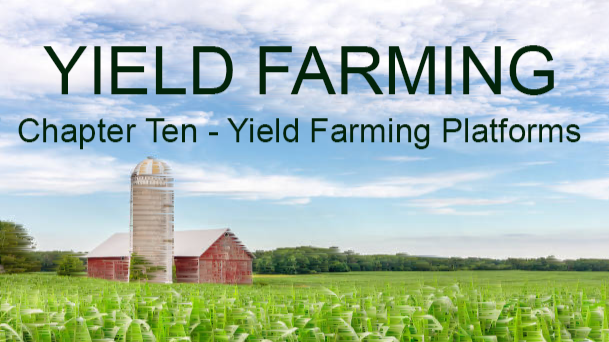Yield Farming Chapter Ten - Yield Farming Platforms

This is Chapter Ten, focused on types of yield farms, the final chapter in a series of articles about yield farming. The purpose of this series is to introduce the concept of yield farming to those who are unfamiliar with it, then move into various yield farming strategies and finally step-by-step walkthrough of the process. I hope you enjoy the series and any feedback you have would be greatly appreciated.
Chapter Ten- Types of Yield Farming Platforms
Platform (noun) an application or website through which users are able to perform actions
Not all yield farms are created equal. Selecting the type of yield farm to get involved with depends on your strategy, risk tolerance and personal preference. Different yield farming platforms serve different purposes and it is important to understand the purpose of each to best reach your own personal goals.
In the process of writing this, I have yet to find a source that describes the types of yield farming platforms that exist so please consider this information as an incomplete guide to all the types of platforms out there.
Protocol vs Platform and Layer 1 vs Layer 2
You will hear the terms protocol and platform used interchangeably, however, they are two different things. A protocol is the base-layer code of a blockchain. The protocol, which sits on top of the internet, helps developers build projects on top of the blockchain itself. A platform is the product that sits on top of the protocol, it is what you are interacting with when performing yield farming actions.
As an example, the internet is accessed via a Hyper Text Transfer Protocol (HTTP) while Amazon is a platform or site built upon it that you can make purchases from.
You may also hear the terms layer 1 and layer 2. Layer 1 is the underlying main blockchain architecture, for example the Bitcoin blockchain. Layer 2 is an overlaying network that lies on top of layer 1, for example the Lightning Network which is a decentralized network that uses smart contracts functionality in the Bitcoin blockchain to enable instant payments across the network's user base.
Lending and Borrowing Yield Farm
Yield farming is still new having first been introduced in 2020 when a decentralized Ethereum lending platform called Compound introduced their governance token COMP and distributed it to its users through an automated system. This was unique in the fact that both lenders and borrowers would earn a portion of the weekly distributed COMP tokens. Ever since its release, users have turned to yield farming to look for ways to increase their returns.
In Compound yield farming, users of the platform are allowed to borrow different tokens against their deposited tokens, then swap those for their original tokens and re-deposit them. Users maximize returns by borrowing multiple times based on a single original deposit.
Liquidity Providing
The success of Compound led to similar platforms and "forks" or offshoots of the same code which lead to further innovations. Curve and Uniswap helped popularize liquidity mining programs that distribute their governance tokens, CRV and UNI respectively, to depositors in its liquidity pools.
Essentially, once a user creates a LP token by combining two tokens they are rewarded by getting a percentage of the transaction fees associated by swapping one token for another within the platform. In-other-words, you "mine" the platform's governance token by simply providing equal amounts of the two tokens someone decides to exchange for one another.
Yield Aggregators
The process involved in a liquidity providing yield farm generally takes place like this:
Swap Token --> Create LP Token --> Deposit in Liquidity Pool --> Claim or Harvest Rewards --> Sell Rewards --> Repeat Process
The issue here is that you pay gas fees in each step which can get expensive considering the number of transactions, especially on a higher cost network like Ethereum where many yield farms exist.
Yield aggregators, like Yearn Finance, solve this problem by pooling users' deposits together and simplifying the entire process by automating much of the work within the platform. While users still need to make deposits and withdrawals, all the other steps are done by the platform itself making them much more user friendly and much less expensive.
A close relative and variation of yield aggregators include "auto vaults" that auto-compound rewards given by third-party yield farms.
Yield Farming Ecosystems
While most of the above platforms allow you to exchange a wide variety of different coins there are platforms now that offer a limited number of "farms" but offer a number of different functions within the platform to generate yields.
These platforms often have a couple of yield farms that create LP tokens using their own native token combined with a popular token such as Ethereum or a stablecoin pegged to the US dollar. These yield farms are the engines of the platform, but rewards from them are put into a different area on the farm to generate rewards in a different token. Even different areas in the platform function differently creating an entire ecosystem within the platform. As such, different strategies within the platform will create different results for users and it is important to understand how the different areas each work and how they can best benefit users.
Whiteboard Crypto YouTube Video's on Specific Yield Farming Platforms
Previous Chapters
Yield Farming Chapter One - What is Yield Farming?
Yield Farming Chapter Two - Decentralized Finance
Yield Farming Chapter Three - Automated Market Maker
Yield Farming Chapter Four - Liquidity Pools
Yield Farming Chapter Five - Smart Contracts
Yield Farming Chapter Six - APR vs APY
Yield Farming Chapter Seven - Gas Fees, Slippage and Other Fees